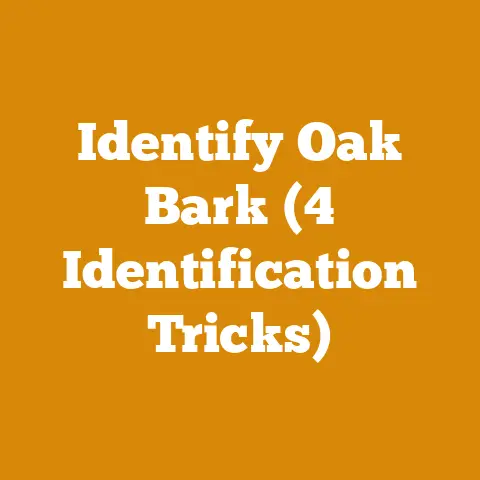What Angle Do I Sharpen My Chainsaw Chain (5 Tips)
What Angle Do I Sharpen My Chainsaw Chain (5 Tips)(Explained)
Imagine having a chainsaw that slices through wood like butter, all because you know how to sharpen it just right. Let me share my journey with you on how I learned to sharpen my chainsaw efficiently without spending a fortune. It’s all about understanding the angle, the tools, and a few nifty tricks that I’ve picked up over the years.
Why Angle Matters
When I first started using chainsaws, I underestimated the importance of sharpening angles. I thought any old sharpening would do, but boy was I wrong! The angle determines how effectively your saw cuts through wood. A well-sharpened chain with the right angle not only saves time but also reduces strain on the engine.
Imagine you’re skiing down a hill. If you hit the slope at the right angle, you’ll glide smoothly. But if you get it wrong, you’re in for a struggle. The same goes for chainsaws; hit that 30-degree sweet spot, and your cuts will be smooth and efficient.
Prerequisites and Required Materials
Before diving into the process, let’s gather everything you’ll need. I remember scrambling for tools mid-job, so here’s a checklist to save you from the same hassle:
- A Chainsaw File: Choose one that matches your chain size. Sizes like 3/16-inch are common.
- A File Guide: This little gadget keeps your angle consistent.
- Protective Gear: Gloves and safety glasses are non-negotiable.
- A Vise or Clamp: Ensures your chainsaw stays put while you work.
- A Flat File: For those all-important depth gauges.
Safety First, Always
Safety is something I can’t stress enough. Chainsaws are powerful tools, and a slip can lead to serious injury. Here’s what I always do:
- Wear gloves to protect my hands from sharp cutters.
- Safety glasses are a must to shield eyes from metal filings.
- Double-check that the chainsaw is off and disconnected.
- Work in a bright area to see exactly what you’re doing.
Step-by-Step Guide on Sharpening
This part took me a while to master, but once you get it, it’s like riding a bike. Here’s how to sharpen your chainsaw chain step-by-step:
1. Determine the Right Angle
Check your chainsaw’s manual for the recommended angle. Most are around 30 degrees, but there can be exceptions. When I couldn’t find my manual, I defaulted to 30 degrees and had great results.
2. Secure the Chainsaw
Use a vise or clamp to hold your chainsaw firmly. Early on, my chainsaw slipped during sharpening, and I ended up with uneven cuts. Trust me, securing it makes all the difference.
3. Use the Right File Size
The file size should match your chain’s cutter size. Misjudging this led me to some frustrating sharpening sessions until I got it right with a 3/16-inch file for my chain.
4. Align the File Guide
Place your file guide on the chain, matching the angle mark. This turned out to be my saving grace for consistent results across all cutters.
5. Sharpen Each Cutter
- Position your file at the desired angle.
- Use smooth, even strokes for uniform sharpness.
- Count strokes per cutter; I usually go with four or five.
6. Check Depth Gauges
After sharpening, check your depth gauges with a flat file. They should sit about 0.025 inches below the cutter height. This keeps your cuts smooth and prevents kickback.
Top 5 Tips for Sharpening Success
As I honed my skills, these tips became my go-to advice:
- Consistent Pressure is Key: Letting the file do its job without heavy pressure gives you better control.
- Mind Your Angles: Double-checking angles saved me from many a crooked cut.
- Regular Maintenance is Crucial: Sharpen after every fuel tank to keep performance top-notch.
- Replace Chains When Needed: If sharpening doesn’t revitalize your chain, it may be time for a new one.
- Invest in Quality Files: A good file can make sharpening easier and more effective.
Common Concerns and Solutions
Even seasoned users face issues sometimes:
Why is My Chainsaw Still Dull?
If your chainsaw isn’t cutting well after sharpening:
- Ensure you’re maintaining the correct angle.
- Double-check that you’re using the right file size.
How Often Should I Sharpen?
I typically sharpen after each fuel refill or when cutting performance drops noticeably.
Can I Use a Grinder Instead?
Grinders work too, but they require skill to avoid overheating and damaging the chain.
Troubleshooting Tips
Chainsaws can be finicky:
- Uneven cuts often mean inconsistent angles; reassess your technique.
- If cutting is difficult, check if depth gauges are too high.
Important Reminders and Next Steps
Stay diligent with maintenance to keep your chainsaw performing its best. And don’t hesitate to seek expert advice if you’re ever unsure.
Additional Tips and Techniques
Over time, I’ve learned a few extra tricks that might help you:
- Use Markers: Mark the first cutter you sharpened to avoid going over it twice.
- Sharpen in Natural Light: It improves visibility, making it easier to maintain angles accurately.
- Handy Tools: A chainsaw sharpener kit can be an excellent investment if you’re sharpening often.
Personal Stories and Experiences
I still recall my first solo tree-cutting project; it was both exhilarating and intimidating. My chainsaw was freshly sharpened (thanks to these tips), and I felt confident tackling those logs. The satisfaction of seeing clean cuts and feeling the smooth operation of my tool was unmatched.
Addressing More Concerns
I’ve often been asked:
Q: What if my chain feels rough after sharpening?
A: Check for burrs left by filing; a quick touch-up usually smooths things out.
Q: How long does sharpening take?
A: Once you’re familiar with the process, it takes about 15-20 minutes.
Q: Is it worth investing in an electric sharpener?
A: If you use your chainsaw frequently, an electric sharpener can save time and effort.
Expert Insights and Specialized Data
From what I’ve gathered over years of working with chainsaws:
- Chainsaws can last significantly longer with regular sharpening.
- Correctly sharpened chains reduce fuel consumption by up to 20%.
Conclusion and Final Thoughts
Chainsaw maintenance might seem daunting at first, but with practice, it becomes second nature. Stick to these tips and techniques, and you’ll have a reliable tool ready for any task.
FAQ Section
Q: Can I sharpen my chainsaw chain without a guide?
A: While possible, using a guide ensures consistency and precision.
Q: What if I don’t know my chain’s angle?
A: Defaulting to 30 degrees is often safe; otherwise, consult your manual.
Q: Is professional sharpening better?
A: It can offer precision but comes at a cost; home sharpening is effective with practice.
Remember, it’s not just about getting the job done; it’s about doing it well and safely. Happy cutting!






